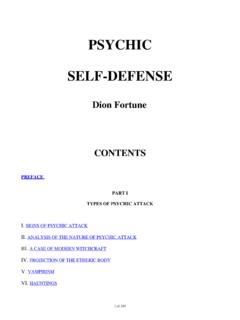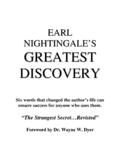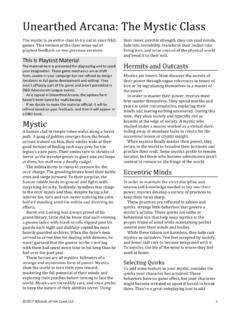Transcription of THE HEART OF A TEACHER Identity and Integrity in Teaching
1 THE HEART OF A TEACHERI dentity and Integrity in TeachingParker J. PalmerThis essay consists of edited excerpts from the Introduction, Chapter I, and Chapter V of ParkerJ. Palmer s new book, The Courage to Teach: Exploring the Inner Landscape of a TEACHER s Life(San Francisco: Jossey-Bass Publishers, 1997), as well as new material written for Teach Who We AreI am a TEACHER at HEART , and there are moments in the classroom when Ican hardly hold the joy. When my students and I discover uncharted territoryto explore, when the pathway out of a thicket opens up before us, when ourexperience is illumined by the lightning-life of the mind then Teaching is thefinest work I at other moments, the classroom is so lifeless or painful orconfused and I am so powerless to do anything about it that my claim to be ateacher seems a transparent sham. Then the enemy is everywhere: in thosestudents from some alien planet, in that subject I thought I knew, and in thepersonal pathology that keeps me earning my living this way.
2 What a fool Iwas to imagine that I had mastered this occult art harder to divine than tealeaves and impossible for mortals to do even passably well!The tangles of Teaching have three important sources. The first two arecommonplace, but the third, and most fundamental, is rarely given its , the subjects we teach are as large and complex as life, so our knowledgeof them is always flawed and partial. No matter how we devote ourselves toreading and research, Teaching requires a command of content that alwayseludes our grasp. Second, the students we teach are larger than life and evenmore complex. To see them clearly and see them whole, and respond to themwisely in the moment, requires a fusion of Freud and Solomon that few of students and subjects accounted for all the complexities of Teaching ,our standard ways of coping would do keep up with our fields as best we can,and learn enough techniques to stay ahead of the student psyche. But there isanother reason for these complexities: we teach who we , like any truly human activity, emerges from one sinwardness, for better or worse.
3 As I teach, I project the condition of my soulonto my students, my subject, and our way of being together. Theentanglements I experience in the classroom are often no more or less thanthe convolutions of my inner life. Viewed from this angle, Teaching holds amirror to the soul. If I am willing to look in that mirror, and not run fromwhat I see, I have a chance to gain self -knowledge and knowing myself is ascrucial to good Teaching as knowing my students and my fact, knowing my students and my subject depends heavily on self -knowledge. When I do not know myself, I cannot know who my students will see them through a glass darkly, in the shadows of my unexaminedlife and when I cannot see them clearly I cannot teach them well. When I donot know myself, I cannot know my subject not at the deepest levels ofembodied, personal meaning. I will know it only abstractly, from a distance, acongeries of concepts as far removed from the world as I am from need to open a new frontier in our exploration of good Teaching :the inner landscape of a TEACHER s life.
4 To chart that landscape fully, threeimportant paths must be taken intellectual, emotional, and spiritual andnone can be ignored. Reduce Teaching to intellect and it becomes a coldabstraction; reduce it to emotions and it becomes narcissistic; reduce it to thespiritual and it loses its anchor to the world. Intellect, emotion, and spiritdepend on each other for wholeness. They are interwoven in the human selfand in education at its best, and we need to interweave them in ourpedagogical discourse as intellectual I mean the way we think about Teaching and learning the form and content of our concepts of how people know and learn, of thenature of our students and our subjects. By emotional I mean the way we andour students feel as we teach and learn feelings that can either enlarge ordiminish the exchange between us. By spiritual I mean the diverse ways weanswer the HEART s longing to be connected with the largeness of life alonging that animates love and work, especially the work called Beyond TechniqueAfter three decades of trying to learn my craft, every class comes downto this: my students and I, face to face, engaged in an ancient and exactingexchange called education.
5 The techniques I have mastered do not disappear,but neither do they suffice. Face to face with my students, only one resource isat my immediate command: my Identity , my selfhood, my sense of this I who teaches without which I have no sense of the Thou who is a secret hidden in plain sight: good Teaching cannot be reducedto technique; good Teaching comes from the Identity and Integrity of theteacher. In every class I teach, my ability to connect with my students, and toconnect them with the subject, depends less on the methods I use than on thedegree to which I know and trust my selfhood and am willing to make itavailable and vulnerable in the service of evidence for this claim comes, in part, from years of askingstudents to tell me about their good teachers. Listening to those stories, itbecomes impossible to claim that all good teachers use similar techniques:some lecture non-stop and others speak very little, some stay close to theirmaterial and others loose the imagination, some teach with the carrot andothers with the in every story I have heard, good teachers share one trait: a strongsense of personal Identity infuses their work.
6 Dr. A is really there when sheteaches, a student tells me, or Mr. B has such enthusiasm for his subject, or You can tell that this is really Prof. C's life. One student I heard about said she could not describe her good teachersbecause they were so different from each other. But she could describe her badteachers because they were all the same: Their words float somewhere infront of their faces, like the balloon speech in cartoons. With one remarkableimage she said it all. Bad teachers distance themselves from the subject theyare Teaching and, in the process, from their teachers join self , subject, and students in the fabric of life becausethey teach from an integral and undivided self ; they manifest in their ownlives, and evoke in their students, a capacity for connectedness. They areable to weave a complex web of connections between themselves, theirsubjects, and their students, so that students can learn to weave a world forthemselves. The methods used by these weavers vary widely: lectures,Socratic dialogues, laboratory experiments, collaborative problem-solving,creative chaos.
7 The connections made by good teachers are held not in theirmethods but in their hearts meaning HEART in its ancient sense, the placewhere intellect and emotion and spirit and will converge in the human good Teaching cannot be reduced to technique, I no longer need sufferthe pain of having my peculiar gift as a TEACHER crammed into the Procrusteanbed of someone else s method and the standards prescribed by it. That pain isfelt throughout education today as we insist upon the method du jour leaving people who teach differently feeling devalued, forcing them tomeasure up to norms not their will never forget one professor who, moments before I was to start aworkshop on Teaching , unloaded years of pent-up workshop animus on me: I am an organic chemist. Are you going to spend the next two days tellingme that I am supposed to teach organic chemistry through role-playing? Hiswry question was not only related to his distinctive discipline but also to hisdistinctive self : we must find an approach to Teaching that respects thediversity of teachers as well as disciplines , which methodologicalreductionism fails to capacity for connectedness manifests itself in diverse andwondrous ways as many ways as there are forms of personal Identity .
8 Twogreat teachers stand out from my own undergraduate experience. Theydiffered radically from each other in technique, but both were gifted atconnecting students, TEACHER , and subject in a community of of those teachers assigned a lot of reading in her course onmethods of social research and, when we gathered around the seminar tableon the first day, said, Any comments or questions? She had the courage towait out our stupefied (and stupefying) silence, minute after minute afterminute, gazing around the table with a benign look on her face and then,after the passage of a small eternity, to rise, pick up her books, and say, as shewalked toward the door, Class dismissed. This scenario more or less repeated itself a second time, but by the thirdtime we met, our high SAT scores had kicked in, and we realized that the bigdollars we were paying for this education would be wasted if we did not getwith the program. So we started doing the reading, making comments, askingquestions and our TEACHER proved herself to be a brilliant interlocutor, co-researcher, and guide in the midst of confusions, a weaver of connectednessin her own interactive and inimitable other great mentor taught the history of social thought.
9 He did notknow the meaning of silence and he was awkward at interaction; he lecturedincessantly while we sat in rows and took notes. Indeed, he became soengaged with his material that he was often impatient with our his classes were nonetheless permeated with a sense of connectednessand did he manage this alchemy? Partly by giving lectures that wentfar beyond presenting the data of social theory into staging the drama of socialthought. He told stories from the lives of great thinkers as well as explainingtheir ideas; we could almost see Karl Marx, sitting alone in the BritishMuseum Library, writing Das Kapital. Through active imagination we werebrought into community with the thinker himself, and with the personal andsocial conditions that stimulated his the drama of my mentor s lectures went farther still. He wouldmake a strong Marxist statement, and we would transcribe it in our notebooksas if it were holy writ. Then a puzzled look would pass over his face. Hewould pause, step to one side, turn and look back at the space he had justexited and argue with his own statement from an Hegelian point of view!
10 This was not an artificial device but a genuine expression of the intellectualdrama that continually occupied this TEACHER s mind and HEART . Drama does not mean histrionics, of course, and remembering thatfact can help us name a form of connectedness that is palpable and powerfulwithout being overtly interactive, or even face-to-face. When I go to thetheater, I sometimes feel strongly connected to the action, as if my own lifewere being portrayed on stage. But I have no desire to raise my hand andrespond to the line just spoken, or run up the aisle, jump onto the stage, andjoin in the action. Sitting in the audience, I am already on stage in person, connected in an inward and invisible way that we rarely credit as thepowerful form of community that it is. With a good drama, I do not needovert interaction to be in community with those characters and their used to wonder how my mentor, who was so awkward in his face-to-face relations with students, managed to simulate community so well.







